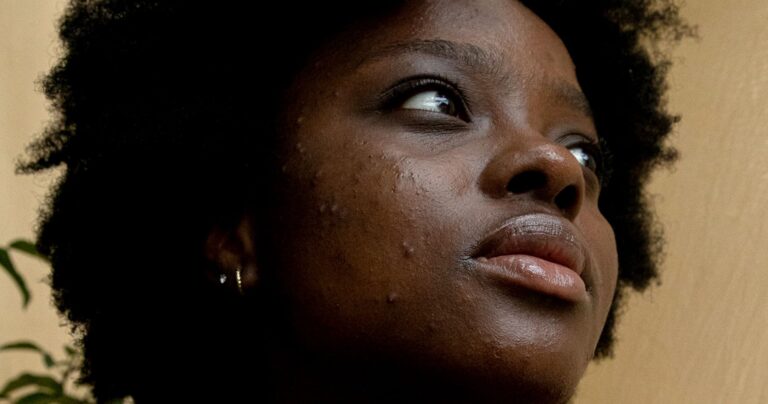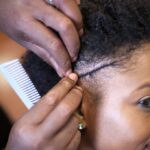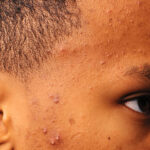Rosacea is a skin condition that causes erythema or redness of the face. It affects all skin types, including rich complexions. African Americans, Latinos and Asians also get affected by acne rosacea, but is oftentimes unnoticed.
Rosacea which is also known as “adult acne”, is a skin disease that comes with facial redness, normal bumps (papules) or pus-filled bumps (pustules). It is often mistaken for other similar skin diseases, and affects over 13 million Americans within the ages 30 to 50 years – hence the nickname adult acne.
Although acne rosacea mostly affects people with lighter skin tone, brown skinned persons are not exempted. As a matter of fact, brown skinned persons who’re of multiple racial descent are prone to suffering rosacea. Although the appearance may be different, the pain is relatively the same.
Causes
Although it is unclear what causes acne rosacea, a handful of theories postulate that rosacea is linked to a surge in the reactivity of blood vessels, lack of supporting tissues for blood vessels, and infection e.g a sting from mite. Furthermore, acne rosacea is worsened by certain things such as spicy food, hot beverages, alcohol, and prolonged exposure to the sun, among others.
Symptoms
The symptoms of rosacea vary from one person to another. The severity of the disease also influences the symptoms that may be experienced. There are four subcategories of acne rosacea, and these come with common and differing symptoms.
Subcategories of Acne Rosacea
1. Erythematotelangiectatic: symptoms include facial flushing, redness and telangiectasias. Persons with rosacea oftentimes have to deal with an increased amount of dilated blood vessels, which result in redness of the skin. The redness is mostly facial, but may appear on other parts of the body. The skin becomes overly sensitive – turns red at the slightest pressure. Swelling and dryness may also be experienced.
2. Papulopustular rosacea: this looks a little more like acne vulgaris. It comes with reddish bumps or pustules (pus-filled bumps). The main difference between it and acne vulgaris is the absence of white or blackheads.
Reddish bumps often appear on the cheeks, chin and in-between the eyebrows. Patients may feel a burning sensation and dryness on the skin. At times brown skinned persons may suffer both rosacea and acne vulgaris – often making it difficult to clearly diagnose the presence of both.
3. Phymatous rosacea: this involves the growth of fibrous tissue in the body, which often results in thickening and enlargement of certain areas of the face – particularly the nose, chin and ears. This is a rare form of rosacea and hardly affects women.
4. Ocular rosacea: affects the eyes mainly. The eyes are often red and irritate, leaving patients with a stinging sensation and inflamed eyes.
Treatment of Rosacea
It is common for rosacea to be mistaken for other skin diseases like acne vulgaris, and lupus erythematosus. However, a dermatologist can differentiate between rosacea and similar diseases, and make prescriptions.
In most cases, a combination of topical prescriptions and oral medications are required to treat rosacea. In certain cases, however, rosacea tends to go away without treatment. Please note that rosacea has no definitive cure, but it can be managed till the symptoms fade.
Persons suffering from rosacea tend to have sensitive and irritable skin, and this is often worsened in brown skinned women who’re prone to skin sensitivity and hyperpigmentation. Hence, it is advised that care is taken when sourcing for skincare products. Avoid harsh products especially if your skin is sensitive and prone to rosacea. See your dermatologist for proper prescription, and avoid self-medication.
Oral antibiotics
Antibiotics and antimicrobial agents have shown promise in combating rosacea – even the most resistant forms. According to reports, the most effective oral antibiotics are sourced from the tetracycline, minocycline and doxycycline family. Low dosages of doxycycline are précised by certain dermatologists, and these helps to quell the inflammation of the skin without risking bacterial resistance. Generally speaking, a duration of 4 to 8 weeks is required when using oral antibiotics for rosacea. Afterwards, medication may be discontinued, while managing the weak strain of rosacea with topical products alone.
Topical antibiotics and antimicrobial agents
In situations where acne rosacea is relatively mild, it can be treated with topical antibiotics or antimicrobial agents. These agents include 1% of clindamycin combined with 5% of benzoyl peroxide, azelaic acid, 5% sulfur mixed with 10% sulfacetamide sodium and metronidazole at 0.75% or 1%.
Topical antibiotics and antimicrobial agents are usually in form of creams, gels, lotions, and washes which are to be applied to the face once or twice per day, over a period of 6 to 8 weeks before any changes can be seen. Side effects such as irritation and stinging sensation on the facial skin, may be experienced.
A recent research has shown that 1% of Clindamycin, 5% of benzoyl peroxide get and 15% azelaic acid gel is highly effectively in treating rosacea. Particularly, the 15% azelaic acid showed greater efficiency compared to previous topical treatments.
Aside the aforementioned treatment, here is a list of common treatments for rosacea;
- Oral antibiotics and Brand names
- Minocycline 50, 75, 100 MG QD-BID Minocin, Dynacin
- Tetracycline 250, 500 MG BID
- Doxycycline 1/100 Pack, 2/100 Pack Adoxa
- Doxycycline 20, 50, 75, 100 MG QD-BID Monodox, Doryx, Adoxa
- Note – MG = milligrams, QD = once a day; BID = twice a day; DS = double strength)
- Topical antibiotics and antimicrobial agents with Brand names
- Clindamycin 1%/ Benzoyl peroxide 5% Benzaclin, Duac
- Azelaic acid 15% Finacea
- Metronidazole 1.0% Noritate Cream
- Sulfacetamide sodium 10% /Sulfa 5% Rosac, Rosanil, Ovace
- Metronidazole 0.75% Metrogel, Metrocream, Metrolotion
Note; there are other forms of treating rosacea. Treatments using laser light and intense pulse light have been shown to reduce the skin redness and telangiectasia. While this is promising, brown skinned women are advised not to use such laser treatments as they can result in hyperpigmentation. Hence, it is advised to talk to your dermatologist first before considering the option of laser treatment.
Triggers of Acne Rosacea
Keeping in mind that prevention is better than cure, ensure you avoid these triggers as much as possible;
- Hot and spicy foods
- Hot tea, coffea or drinks
- Alcohol and red wine
- Hot weather
- Prolonged exposure to the sun (apply sunscreen in this case)
- Frequent hot showers.
Corticosteroid rosacea
What should otherwise be a source of beauty has over time turned into a harmful mess. Corticosteroid rosacea happens when cortisone creams are used by women with rich complexion, wrongly and for way too long. Cortisone creams are unique to certain skin types, but are harsh towards brown skin. Should you wish to use cortisone cream as a brown skinned woman, be sure it is prescribed by your dermatologist, and only used for a short while. Applying cortisone creams on your face may seem like a great idea, but the results overtime is not thrilling. The initial skin glow would eventually result in redness and telangiectasias associated with rosacea. This is often as a result of skin thinning caused by continued use of cortisone creams.
In all, rich complexion women are better off without cortisone creams, as they risk skin thinning and a host of symptoms associated with rosacea.



